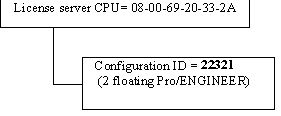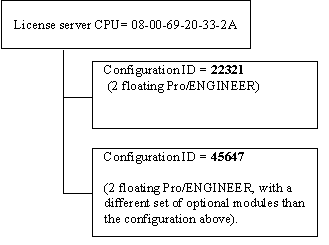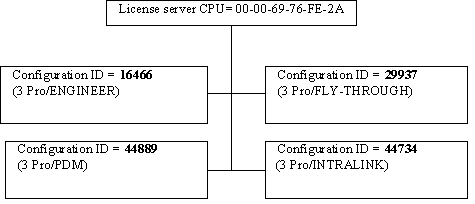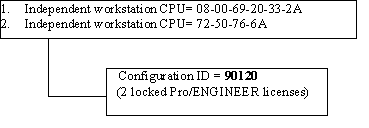]
Configuration IDs
With the integration of FLEXlm, Configuration IDs will replace serial numbers as the primary way of identifying your software and identifying yourself to PTC Technical Support. Configuration IDs have been assigned to your existing licenses and will be referenced on all License Packs instead of install numbers.
Configuration ID Notes
- PTC will continue to use serial numbers to license software until the implementation of FLEXlm.
- Configuration IDs will now be used to identify your software and yourself to PTC Technical Support.
- Configuration IDs will now be listed on all License Packs instead of install numbers.
- Configuration IDs have been given to your existing licenses. Your serial numbers and license configuration did not change as a result of adding the Configuration IDs.
What is a Configuration ID?
A Configuration ID is a number used for administrative and ultimately, licensing purposes to identify and track your software. Each Configuration ID represents a single configuration of products in a PTC product family for a single machine.
It is important to understand four basic rules surrounding Configuration IDs. It is recommended that you read the following rules, then review the examples showing how the rules are applied.
Rule #1: A unique Configuration ID will be given to each configuration of PTC software on the same machine or license server.
Rule #2: A single Configuration ID can not span cpu_ids (for floating products).
Rule #3: A single Configuration ID can not span PTC product lines.
Rule #4: A single Configuration ID will have a single maintenance status.
Example of Configuration ID Rule #1: A unique Configuration ID will be given to each configuration of PTC software on the same machine or license server.
A customer purchases two floating licenses of Pro/ENGINEERâ to be installed on a single license server.

In the example above, a single Configuration ID is given. This number will identify a single configuration of products for a single product family on a single machine. If the same customer then purchases two additional licenses of Pro/ENGINEER configured with a different set of optional modules, a separate Configuration ID will be given for the new software.

In the example above, another unique Configuration ID is given because the customer has two different configurations of the same product (Pro/ENGINEER) on the same license server.
It is also important to know that if Pro/PDM , Pro/INTRALINK, and/or Pro/FLY-THROUGH were ordered with both Pro/ENGINEER configurations above, one Configuration ID would be given to each of these additional products since the configurations of these products are the same. The Pro/ENGINEER licenses are given two Configuration IDs because the module configurations are different.
Example of Configuration ID Rule # 2: A single Configuration ID can not span cpu_ids (for floating products).
A customer purchases six floating licenses of Pro/ENGINEER; each license configured with the same set of optional modules. The six licenses are to be split between two different license servers.

In the example above, two unique Configuration IDs are given because two license servers are being used even though the software configuration is the same. Note that both configurations have the same serial number.
Example of Configuration ID Rule # 3: A single Configuration ID can not span product lines.
The customer purchases three licenses of PTC's Advanced Designer Package III that includes licenses of Pro/ENGINEER, Pro/FLY-THROUGH, Pro/PDM, and Pro/INTRALINK. All products are to be installed on a single license server. See graphic below.

Four unique Configuration IDs are given because the four different product families are licensed on the same server.
Configuration IDs and Locked Licenses
Locked licenses are the exception to Configuration ID Rule # 2 that states a Configuration ID can not span cpu_ids. PTC will allow a single Configuration ID to be licensed to multiple machines for a single locked software configuration. In other words, the number of locked licenses on a single Configuration ID represents the number of independent workstations listed for that Configuration ID.

Please note the example above applies to locked licenses only.
Conversion of Your Licenses to Configuration IDs
In order to implement the new Business Administration system, your existing licenses where carefully transferred to the new system. Your serial numbers were not changed and should continue to be used to identify yourself to PTC Technical Support.
Configuration IDs have been given to your existing licenses. In most cases your license configuration did not change as a result of adding the Configuration IDs. However it is important to note that your licenses will now follow the Configuration ID rules outlined in the previous section.
How Will Your Existing License Change?
The following examples compare the install number licensing to the new Configuration ID licensing scheme for the same given software configuration. The column on the left shows how you identify your software currently, while the column on the right shows how the same software configuration will be represented in the new Business Administration System.
Locked Licenses
Example 1: The customer purchases one locked license of one product, (Pro/ENGINEER).
|
Prior to October 20, 1997 |
FLEXlm Licensing |
| 1 serial number (10-10-33-A3) | 1 Configuration ID that identifies 1 license of Pro/ENGINEER (66451) |
| 1 install number (34335) |
Example 2: The customer purchases eight locked license of one product (Pro/ENGINEER).
|
Prior to October 20, 1997 |
FLEXlm Licensing |
| 1 serial number (10-10-77-D2) | 1 Configuration ID that identifies 8 license of Pro/ENGINEER (73633) |
| 8 install numbers (2233, 2234, etc.) |
Example 3: The customer purchased one locked license of two products; Pro/ENGINEER and Pro/DESIGNER . Both licenses are to be used on the same machine.
|
Prior to October 20, 1997 |
FLEXlm Licensing |
| 1 Pro/ENGINEER serial number (10-10-11-99) | 1 Configuration ID that identifies 1 license of Pro/ENGINEER (17349) |
| 1 Pro/DESIGNER serial number (10-90-37-B2) | 1 Configuration ID that identifies 1 license of Pro/DESIGNER (17357) |
| 1 Pro/ENGINEER install number (48459) | |
| 1 Pro/DESIGNER install number (48460) |
Floating Products
Example 1: The customer purchased ten floating licenses of one product (Pro/ENGINEER) to be installed on 1 license server.
|
Prior to October 20, 1997 |
FLEXlm Licensing |
| 1 Pro/ENGINEER serial number (10-10-B1-11) | 1 Configuration ID that identifies 10 Pro/ENGINEER licenses (11470) |
| 10 install numbers (3311, 3312, etc.) |
Example 2: The customer purchased ten floating licenses of one product, (Pro/ENGINEER). The licenses to be split between two different license servers.
|
Prior to October 20, 1997 |
FLEXlm Licensing |
| 1 Pro/ENGINEER serial number (10-11-71-DD) | 2 Configuration IDs** each identifies the number of licenses per server (1717, 1718) |
| 10 install numbers, 5 for each server (7711, 7712, etc.) |
** Two Configuration IDs are given because Configuration IDs can not span cpu_ids. See Configuration ID Rule # 2.
Example 3: The customer purchased ten floating licenses of the Advanced Designer Package III, which includes Pro/ENGINEER, Pro/PDM, Pro/INTRALINK, and Pro/FLY-THROUGH. The licenses are to be installed on one license server.
|
Prior to October 20, 1997 |
FLEXlm Licensing |
| 1 Pro/ENGINEER serial
number
(10-11-AB-BC) |
1 Configuration ID that identifies 10 Pro/ENGINEER licenses (2290) |
| 1 Pro/PDM serial number
(10-50-AB-BC) |
1 Configuration ID that identifies 10 Pro/PDM licenses (2291) |
| 1 Pro/INTRALINK serial
number
(11-70-AB-BC) |
1 Configuration ID that identifies 10 Pro/INTRALINK licenses (2293) |
| 1 Pro/FLY-THROUGH serial number (11-31-AB-BC) | 1 Configuration ID that identifies 10 Pro/FLY-THROUGH licenses (2294) |
| 10 Pro/ENGINEER install numbers (1177, 1118, etc.) | |
| 1 Pro/PDM install number with 10 accesses (1131) | |
| 1 Pro/INTRALINK install number with 10 accesses (1132) | |
| 10 Pro/FLY-THROUGH install numbers (1133, 1134, etc.) |
Example 4: The customer purchased three floating Pro/SHEETMETAL modules, five floating Pro/CABLING modules and six floating Pro/MESH modules to be loaded on a single license server.
|
Prior to October 20, 1997 |
FLEXlm Licensing |
| Serial numbers do not apply to floating modules, so no serial number should be issued | 1 Configuration ID that identifies all floating modules (6696) |
| Up to 3 installs could have been created for this example. (4545, 4547, 4547) |